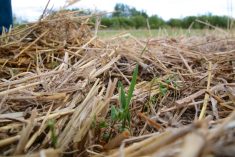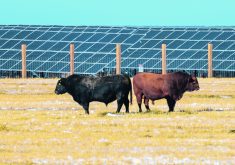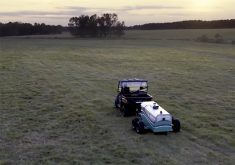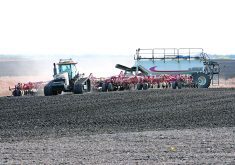If carbon credit systems are to be effective for farmers, it is vital for government officials to reach out to producers to understand what they want and what they’re capable of doing, says a researcher.
“Farmers know their land best, and I think a lot of researchers and individuals who are creating these programs don’t always think about the farmer at the end of the day,” said Sarah Van Wyngaarden, a graduate research assistant at the University of Alberta’s Department of Resource Economics and Environmental Sociology.
Read Also

Government, industry seek canola tariff resolution
Governments and industry continue to discuss how best to deal with Chinese tariffs on Canadian agricultural products, particularly canola.
“They just think about how we can mitigate emissions as fast as possible… the other thing is also ensuring that we come up with protocols that are suitable for agriculture.”
Van Wyngaarden is the author of a report that examined the effectiveness of Alberta’s carbon credit system for farmers. It was recently published by the Simpson Centre for Agricultural and Food Innovation and Public Education at the University of Calgary’s School of Public Policy.
It found that producers “weren’t making almost any money with respect to selling (credits) on the carbon offset market,” she said. As a result, it likely isn’t covering the cost of changing their practices to reduce emissions as required by the system, she added.
“And farmers are stewards of the land. They care about the environment, and a lot of them are naturally going to try to find ways to improve their environment to improve their yields, but they’re also a business, so if they’re taking time and money to put on this practice, they need to be compensated…”
The main economic benefits for farmers are instead indirect ones from adopting practices such as no tillage that help improve things such as efficiency and yields, eventually boosting long-term profitability, she said.
The report said things such as feed efficiency or improved soil conditions “may take years of hard work and management changes to show any private benefits for the producers. These factors play into risk perceptions and financial barriers, creating an obstacle towards participation.”
However, as rising carbon taxes boost carbon prices, revenue from credits will eventually outweigh the cost of implementing new practices, potentially improving participation, said the report. “While waiting for the carbon price to increase, it is in the Alberta government’s best interest to determine a method to demonstrate indirect benefits to producers.”
A recent separate report, titled Realizing the Potential for Agtech in Alberta, partly examined using carbon credits to fund the adoption of new technologies such as precision agriculture. Led by the Thrive program of SVG Ventures, it was prepared for the provincial government and developed in partnership with Olds College and the United Farmers of Alberta Co-operative Ltd.
Although Alberta has what it takes to be a global leader in agricultural innovation, farming lags other industries when it comes to digitization and adopting new technological solutions, said the report.
“Proponents for a system in which farmers can be compensated for being food stewards of their land argue that (credits) will be a powerful mechanism for simultaneously addressing global challenges with biodiversity and climate change and improving the economic health and resilience of agricultural operations.”
Alberta, British Columbia and Quebec each have their own voluntary carbon credit systems, with four out of 19 active protocols in Alberta aimed at agriculture. Such protocols provide standards that participants must follow to generate credits, which can then be purchased by large-scale regulated emitters such as oil and gas companies that aren’t meeting their requirements for emission reduction.
Several federal agricultural protocols, including livestock feed management, are currently being developed under a voluntary national greenhouse gas offset credit system that was recently launched by Ottawa. However, if a province already has an active protocol for the same type of projects, the matching federal protocol will not be applied.
Van Wyngaarden said one of the problems faced by farmers is they are individually too small to generate enough credits to be attractive to buyers such as large-scale emitters. It means such credits are often gathered from several farmers by aggregators, which are businesses that act as intermediaries between the two sides.
As a result, as much as a third of the credit revenue generated by farmers under Alberta’s system ends up going to aggregators to pay for their services, she said. Aggregation is one of the ways Ottawa plans to make it easier for farmers to participate in the new federal system, said spokesperson Amelie Desmarais of Environment and Climate Change Canada in an earlier email.
Van Wyngaarden’s report said a further problem with Alberta’s system is farmers mostly have only participated under the Conservation Cropping Protocol. “To date, no other agricultural protocols have been able to amass the same level of participation. This should warrant concerns as the Conservation Cropping Protocol was retired Dec. 31, 2021.”
Producers readily adopted no-tillage under the protocol, likely because the practice has “been around for quite some time,” said Van Wyngaarden. “Extension agents in Alberta have gone basically around to discuss and provide information to farmers on how conservation tillage can be profitable as well as beneficial for their lands.”
By contrast, the remaining three agriculture protocols have only provided less than one percent of credits issued from the agriculture sector, said the report. These are the Agricultural Nitrous Oxide Emission Reductions Protocol, the Reducing Greenhouse Gas Emissions from Fed Cattle Protocol, and the Selection for Low Residual Feed Intake Markers in Beef Cattle Protocol.
“The government of Alberta must act to address limitations under active agricultural quantification protocols, such as the limited opportunities for different types of livestock producers,” said the report.
“With the loss of the Conservation Cropping Protocol, and without avid participation in other protocols, a stagnant market for agricultural carbon credits is likely. A key spillover effect will include unrealized emission reductions from the agricultural industry.”
The two livestock protocols only have a maximum of five farms participating in some projects, said the report. “This is a major shortfall since these protocols have high emission reduction potential,” it said.
“Further, a number of past protocols were revoked for various reasons, including high complexity, practicality or implementation challenges and other unknown reasons. This constraint limited the type of producer (e.g. dairy, feedlot, etc.) that can participate in the market.”
For a copy of the report, visit https://bit.ly/3QBo3E7.


















